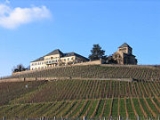
Schloss Johannisberg
Encyclopedia
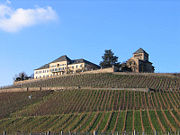
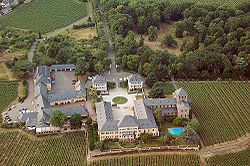
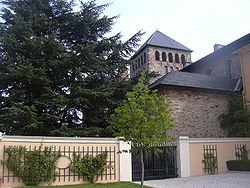
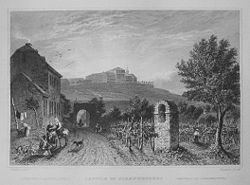
Rheingau (wine region)
Rheingau is one of 13 German wine regions for quality wines . Named for the traditional region of Rheingau , the wine region is situated in the state of Hesse, where it makes up part of the Rheingau-Taunus-Kreis administrative district...
in Germany, that has been making wine for over 900 years. The winery is most noted for its claim to have "discovered" late harvest wine
Late harvest wine
Late harvest is a term applied to wines made from grapes left on the vine longer than usual. Late harvest is usually an indication of a sweet dessert wine, such as late harvest Riesling. Late harvest grapes are often more similar to raisins, but have been naturally dehydrated while on the vine...
.
History
A mountain on the north bank of the River Rhine near MainzMainz
Mainz under the Holy Roman Empire, and previously was a Roman fort city which commanded the west bank of the Rhine and formed part of the northernmost frontier of the Roman Empire...
has been associated with the Church and with winemaking since the Dark Ages, when Ludwig der Fromme ("Louis the Pious
Louis the Pious
Louis the Pious , also called the Fair, and the Debonaire, was the King of Aquitaine from 781. He was also King of the Franks and co-Emperor with his father, Charlemagne, from 813...
") made 6000 litres of wine during the reign of Charlemagne
Charlemagne
Charlemagne was King of the Franks from 768 and Emperor of the Romans from 800 to his death in 814. He expanded the Frankish kingdom into an empire that incorporated much of Western and Central Europe. During his reign, he conquered Italy and was crowned by Pope Leo III on 25 December 800...
. In 1100, Benedictine
Benedictine
Benedictine refers to the spirituality and consecrated life in accordance with the Rule of St Benedict, written by Benedict of Nursia in the sixth century for the cenobitic communities he founded in central Italy. The most notable of these is Monte Cassino, the first monastery founded by Benedict...
monks completed a monastery on the Bischofsberg ("Bishop's") mountain, having identified the site as one of the best places to grow vines. 30 years later they built a Romanesque basilica in honour of John the Baptist
John the Baptist
John the Baptist was an itinerant preacher and a major religious figure mentioned in the Canonical gospels. He is described in the Gospel of Luke as a relative of Jesus, who led a movement of baptism at the Jordan River...
, and the hill became known as Johannisberg (John's mountain). It was constructed according to similar floor plans as its mother house, St. Alban's Abbey, Mainz
St. Alban's Abbey, Mainz
St. Alban's Abbey, Mainz originated as a Benedictine abbey, founded in 787 or 796 by Archbishop Richulf in honour of Saint Alban of Mainz, located to the south of Mainz on the hill later called the Albansberg. It was turned into a collegiate foundation in 1442...
. As such the monastery was a prime target for the Anabaptist
Anabaptist
Anabaptists are Protestant Christians of the Radical Reformation of 16th-century Europe, and their direct descendants, particularly the Amish, Brethren, Hutterites, and Mennonites....
s in the German Peasants' War
German Peasants' War
The German Peasants' War or Great Peasants' Revolt was a widespread popular revolt in the German-speaking areas of Central Europe, 1524–1526. At its height in the spring and summer of 1525, the conflict involved an estimated 300,000 peasants: contemporary estimates put the dead at 100,000...
of 1525, and it was destroyed.
In 1716, Konstantin von Buttlar, Prince-Abbot of Fulda
Fulda
Fulda is a city in Hesse, Germany; it is located on the river Fulda and is the administrative seat of the Fulda district .- Early Middle Ages :...
, bought the estate from Lothar Franz von Schönborn
Lothar Franz von Schönborn
Lothar Franz von Schönborn was the Archbishop-Elector of Mainz from 1694 until 1729, and the Bishop of Bamberg from 1693 until 1729.Lothar Franz was born in Steinheim am Main in 1655 to Count Philip Erwin of Schönborn...
, started construction of the baroque palace, and, in 1720, planted Riesling
Riesling
Riesling is a white grape variety which originated in the Rhine region of Germany. Riesling is an aromatic grape variety displaying flowery, almost perfumed, aromas as well as high acidity. It is used to make dry, semi-sweet, sweet and sparkling white wines. Riesling wines are usually varietally...
vines, making it the oldest Riesling vineyard in the world. The estate changed hands several times during the Napoleonic Wars, but in 1816 the Holy Roman Emperor, Francis II
Francis II, Holy Roman Emperor
Francis II was the last Holy Roman Emperor, ruling from 1792 until 6 August 1806, when he dissolved the Empire after the disastrous defeat of the Third Coalition by Napoleon at the Battle of Austerlitz...
, gifted it to the great Austrian statesman Prince von Metternich
Klemens Wenzel von Metternich
Prince Klemens Wenzel von Metternich was a German-born Austrian politician and statesman and was one of the most important diplomats of his era...
.
In 1942, the Schloss was bombed and reduced to a shell by the air raids on Mainz in 1942. By the mid-1960s it had been largely rebuilt by Prince Paul Alfons von Metternich and his wife Princess Tatiana
Tatiana von Metternich-Winneburg
Tatiana von Metternich-Winneburg was a German patron of the arts of Russian birth. She published her books and watercolours under the name Tatiana von Metternich. She supported charity, especially the Red Cross and the Order of St...
, who had fled there on a farm cart in 1945 after the Russians had advanced on their other estates. Prince Paul died in 1992, leaving no heir, but a significant portion of his fortune to his mistress. Although Princess Tatiana was allowed to reside in the Schloss until her death in 2006, the situation forced her to sell the estate to the German Oetker family
Dr. Oetker
Dr. Oetker is a German company that produces baking powder, cake mixes, yogurts, frozen pizza and pudding.Also included in the portfolio are a maritime freight business, a bank, a publishing company, an insurance outfit, a brewery and a number of high class hotels all over...
. There are currently about 35 hectares (86 acres) of vineyard.
Late harvest wines
Tradition has that a messenger from the Heinrich von BibraHeinrich von Bibra
Heinrich von Bibra , Prince-Bishop, Prince-Abbot of Fulda was Prince-Bishop from 1759 to 1788.-Biography:...
, Prince-Bishop and Abbot of Fulda
Fulda
Fulda is a city in Hesse, Germany; it is located on the river Fulda and is the administrative seat of the Fulda district .- Early Middle Ages :...
, was 14 days late in bringing the papers to give the cellar master permission to start harvesting the grapes. At least two alternative stories exist to explain the delay. One is that the Prince-Bishop was away hunting and was not available to sign the permission to harvest, and the other is that he was intercepted and held by highwaymen. By this time the grapes had become affected with the "noble rot
Noble rot
Noble rot is the benevolent form of a grey fungus, Botrytis cinerea, affecting wine grapes. Infestation by Botrytis requires moist conditions, and if the weather stays wet, the malevolent form, "grey rot", can destroy crops of grapes...
" Botrytis cinerea. The rotted grapes were then given to the local peasants who ended up making wine of high quality. In 1775, Schloss Johannisberg made the first Spätlese
Spätlese
Spätlese is a German wine term for a wine from fully ripe grapes, the lightest of the late harvest wines. Spätlese is a riper category than Kabinett in the Prädikatswein category of the German wine classification and is the lowest level of Prädikatswein in Austria, where Kabinett is classified in...
level Riesling followed by an Auslese
Auslese
Auslese is a German language wine term for a late harvest wine and is a riper category than Spätlese in the Prädikatswein category of the Austrian and German wine classification. The grapes are picked from selected very ripe bunches in the autumn , and have to be hand picked...
level wine in 1787 and an Eiswein in 1858. Unfortunately for the Germans, the Tokay
Tokay
Tokay may refer to:* Tokaji wine , wines produced in the Tokaj-Hegyalja region of Hungary* Tokaj , wine region in South-Eastern Slovakia and wines produced in that region.* Grape varieties:...
classification of 1730 relied in part on an area's propensity to noble rot, which suggests that the Hungarians got there first.
Historically the estate used different colour seals for grapes of different ripeness. These classifications were used as the basis for the new German wine classification
German wine classification
German wine classification consists of several quality categories and is often the source of some confusion, especially among non-German speaking wine consumers. The official classification is set down in the wine law of 1971, although some changes and amendments have been made since then...
of 1971, thus :
| Gelblack | Yellow | Qualitätswein |
| Rotlack | Red | Kabinett |
| Grünlack | Green | Spätlese |
| Silberlack | Silver | "Erstes Gewächs" |
| Rosalack | Pink | Auslese |
| Rosa-Goldlack | Pink-gold | Beerenauslese |
| Goldlack | Gold | Trockenbeerenauslese |
| Blaulack | Blue | Eiswein |
Schloss Johannisberg is a single vineyard designation (Einzellage) in its own right, and one of a handful historic German vineyards which do not have to display a village name on the label. Thus, the vineyard designation on the label is Schloß Johannisberger.
Geology
The 35 ha of vineyards consist of a loam-loess topsoil lying on a Taunus quartzite. The soils are quite stony and gravelly, enabling them to retain the day's temperature and to buffer temperature differences.Visitors
The estate offers guided tours with tastings, a wine bar, shop, and various special events.Basilika
The church of the castle, called Basilika, was originally built for a Benedictine monastery and dedicated to St. Johannes (St. John the BaptistJohn the Baptist
John the Baptist was an itinerant preacher and a major religious figure mentioned in the Canonical gospels. He is described in the Gospel of Luke as a relative of Jesus, who led a movement of baptism at the Jordan River...
). After the destruction during World War II it was rebuilt as a Romanesque
Romanesque architecture
Romanesque architecture is an architectural style of Medieval Europe characterised by semi-circular arches. There is no consensus for the beginning date of the Romanesque architecture, with proposals ranging from the 6th to the 10th century. It developed in the 12th century into the Gothic style,...
basilica and has served as the Catholic parish church for of the village Johannisberg
Johannisberg
Johannisberg is a village in Hessen, Germany. It is part of the city of Geisenheim in the Rheingau, on the right bank of the Rhine, 6 m. S. of Rüdesheim by railway....
. It is also used for concerts of sacred music, of local groups and for concerts of the Rheingau Musik Festival
Rheingau Musik Festival
The Rheingau Musik Festival is an international summer music festival in Germany, founded in 1987. It is mostly for classical music, but includes other genres...
, such as a performance of the Huelgas Ensemble
Huelgas Ensemble
The Huelgas Ensemble is a Belgian early music group formed by the Flemish conductor Paul Van Nevel in 1971. The group's performance and extensive discography focuses on renaissance polyphony...
.
In 1999, combined choirs of Geisenheim
Geisenheim
Geisenheim is a town in the Rheingau-Taunus-Kreis in the Regierungsbezirk of Darmstadt in Hessen, Germany, and is known as Weinstadt , Schulstadt , Domstadt and Lindenstadt ....
and St. Martin, Idstein
St. Martin, Idstein
St. Martin in Idstein, Rheingau-Taunus-Kreis, is the church of the local Roman Catholic parish. The official name is Katholische Pfarrkirche St. Martin. The parish is part of the Diocese of Limburg...
, performed Giacomo Puccini
Giacomo Puccini
Giacomo Antonio Domenico Michele Secondo Maria Puccini was an Italian composer whose operas, including La bohème, Tosca, Madama Butterfly, and Turandot, are among the most frequently performed in the standard repertoire...
's Messa di Gloria
Messa (Puccini)
Giacomo Puccini's Messa or Messa a quattro voci is a Mass composed for orchestra and four-part choir with tenor, bass and baritone soloists...
and, in 2001, Rutter's Requiem
Requiem (Rutter)
The Requiem by John Rutter is a musical setting of an adaptation of the Roman Catholic Requiem Mass, completed in 1985. The setting utilises a choir with an orchestral accompaniment, along with a soprano soloist. The Requiem was first performed on 13 October 1985 at Lovers' Lane United Methodist...
and Benjamin Britten
Benjamin Britten
Edward Benjamin Britten, Baron Britten, OM CH was an English composer, conductor, and pianist. He showed talent from an early age, and first came to public attention with the a cappella choral work A Boy Was Born in 1934. With the premiere of his opera Peter Grimes in 1945, he leapt to...
's The Company of Heaven for speakers, soloists, chorus and orchestra (1937, not performed again until 1989). In 2009, the Neue Rheingauer Kantorei performed Haydn's Die Schöpfung
The Creation structure
The Creation, the oratorio by Joseph Haydn, is structured in three parts. He composed it in 1796–1798 on German text as Die Schöpfung. The work is set for soloists, chorus and orchestra. Its movements are listed in tables for their form, voice, key, tempo marking, time signature and...
with soloists Elisabeth Scholl
Elisabeth Scholl
- Professional career :Elisabeth Scholl was the first girl to sing with the boys choir Kiedricher Chorbuben. From 1982 to 1987 she sang the role of the First Boy in Mozart's Die Zauberflöte at the Hessisches Staatstheater Wiesbaden...
, Daniel Sans
Daniel Sans
- Professional career :Daniel Sans was a boy soprano in the choir of the Mainz Cathedral. He studied at the Musikhochschule in Frankfurt with Martin Gründler...
and Andreas Pruys
Andreas Pruys
- Professional career :Andreas Pruys studied singing and church music at the Folkwanghochschule in Essen. He worked as a church musician for several years, also as director of the music school in Emmerich. He has been a member of the choir NDR Chor since 2001....
.
Concert hall for the Rheingau Musik Festival
The Ostflügel (East Wing) of the castle was rebuilt after the destruction to serve as a tennis court. Tatiana von Metternich-WinneburgTatiana von Metternich-Winneburg
Tatiana von Metternich-Winneburg was a German patron of the arts of Russian birth. She published her books and watercolours under the name Tatiana von Metternich. She supported charity, especially the Red Cross and the Order of St...
, a co-founder of the Rheingau Musik Festival
Rheingau Musik Festival
The Rheingau Musik Festival is an international summer music festival in Germany, founded in 1987. It is mostly for classical music, but includes other genres...
, turned the hall into a public concert venue, staging 10 of the 19 concerts of the first summer season in 1988, and many recitals and chamber music performances every year following. After her husband's death the hall was named "Fürst-von-Metternich-Saal". von Metternich-Winneburg was "Vorsitzende des Kuratoriums" (president of the festival's curator
Curator
A curator is a manager or overseer. Traditionally, a curator or keeper of a cultural heritage institution is a content specialist responsible for an institution's collections and involved with the interpretation of heritage material...
s) until her death. The tradition has been continued by the present owners.

